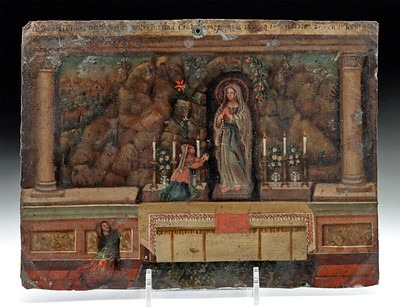Alison Dearborn Painting - "Divine Revelation" (2008)
Lot 212
About Seller
Artemis Gallery
686 S Taylor Ave, Ste 106
Louisville, CO 80027
United States
Selling antiquities, ancient and ethnographic art online since 1993, Artemis Gallery specializes in Classical Antiquities (Egyptian, Greek, Roman, Near Eastern), Asian, Pre-Columbian, African / Tribal / Oceanographic art. Our extensive inventory includes pottery, stone, metal, wood, glass and textil...Read more
Estimate:
$1,200 - $1,800
Absentee vs Live bid
Two ways to bid:
- Leave a max absentee bid and the platform will bid on your behalf up to your maximum bid during the live auction.
- Bid live during the auction and your bids will be submitted real-time to the auctioneer.
Bid Increments
| Price | Bid Increment |
|---|---|
| $0 | $25 |
| $300 | $50 |
| $1,000 | $100 |
| $2,000 | $250 |
| $5,000 | $500 |
| $10,000 | $1,000 |
| $20,000 | $2,500 |
| $50,000 | $5,000 |
| $100,000 | $10,000 |
| $200,000 | $20,000 |
About Auction
By Artemis Gallery
Jun 15, 2023
Set Reminder
2023-06-15 10:00:00
2023-06-15 10:00:00
America/New_York
Bidsquare
Bidsquare : VARIETY Ancient, Ethno, Native American, Fine Art
https://www.bidsquare.com/auctions/artemis-gallery/variety-ancient-ethno-native-american-fine-art-12990
Antiquities, ethnographic, native american and fine art from cultures encompassing the globe. Artemis Gallery info@artemisgallery.com
Antiquities, ethnographic, native american and fine art from cultures encompassing the globe. Artemis Gallery info@artemisgallery.com
- Lot Description
Alison Dearborn (American, Contemporary). "Divine Revelation" acrylic paint on canvas, 2008. Signed on lower right and again with title on verso. A remarkable painting by Alison Dearborn whose works pay tribute to magnificent creatures of the animal kingdom in a manner inspired by prehistoric cave paintings. In "Divine Revelation" Dearborn presents a large cave bear in profile walking toward the left with abstract symbols - an orb above two concentric "U" shaped rays and a spiral motif beside an orb - at the upper left and right corners respectively. All is delineated in rich shades of gold, russet red, violet, indigo, slate blue, and plum with lighting that suggests firelight, a bridge across time, or perhaps a transition between the seasons. Dearborn's technique involves painstakingly applying thin layers of translucent paint, and the resulting textures give the impression that the composition was painted on stone. A striking painting by Alison Dearborn capturing the magic of Paleolithic paintings that decorated the walls and ceilings of caves such as Lascaux and Altamira. Size: 34.125" L x 40.125" W (86.7 cm x 101.9 cm)
The cave bear (Ursus spelaeus) was a European species that became extinct 25,000 years ago. Male cave bears weighed up to 1,500 pounds, which is 50 percent more than today's largest grizzlies. In addition, they had wider heads and very strong shoulders and forelimbs. Countless bear bones have been found in caves where prehistoric bears hibernated, from Spain to Romania. Just what led to the demise of the cave bear is still being investigated. Some suggest cave bears could not adapt to climate change during the last ice age. However, a recent study proposes that as Neanderthals and modern humans moved into caves, the bears had fewer places to hibernate, thus leading to a shelter shortage that perhaps in combination with climate change led to the cave bear's extinction. (Source: Andrew Curry, "Fate of the Cave Bear: The lumbering beasts coexisted with the first humans for tens of thousands of years and then died off. Why?" Smithsonian Magazine December 2010 )
The meaning and purpose of cave art has posed a mystery for decades and is still up for debate. Since most surviving images depict animals, some scholars have linked these parietal paintings to the practice of hunting - serving as an attempt to control the animals early humans hunted via visual representations. However, others have challenged this interpretation, arguing that since the locations of these cave paintings were oftentimes difficult to access, far from the locations where early humans were thought to live, and only accessible by crawling through long circuitous passageways, it is possible that cave paintings were part of a religious ritual. This remote placement in concert with the immense scale and grandeur of cave paintings have led scholars to suggest that these sanctuaries were holy places reserved for spiritual practices. Interestingly, abstract symbols like the ones Dearborn included in this work have been found throughout prehistoric caves as well as on the bone implements within the caves, and some experts believe these symbols may represent early forms of written language.
Provenance: private Boulder, Colorado, USA collection
All items legal to buy/sell under U.S. Statute covering cultural patrimony Code 2600, CHAPTER 14, and are guaranteed to be as described or your money back.
A Certificate of Authenticity will accompany all winning bids.
We ship worldwide and handle all shipping in-house for your convenience.
#175312Overall superb. Signed on lower right and again with title on verso. Stunning painting that extends to the sides of the canvas. Fit with suspension wire on verso and ready to display.Condition
- Shipping Info
-
All shipping is handled in-house for your convenience. Your invoice from Artemis Gallery will include shipping calculation instructions. If in doubt, please inquire BEFORE bidding for estimated shipping costs for individual items.
-
- Buyer's Premium



 EUR
EUR CAD
CAD AUD
AUD GBP
GBP MXN
MXN HKD
HKD CNY
CNY MYR
MYR SEK
SEK SGD
SGD CHF
CHF THB
THB














